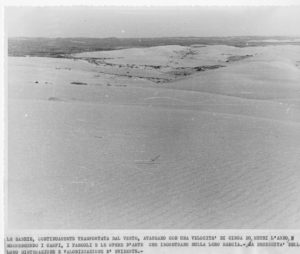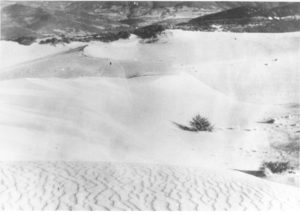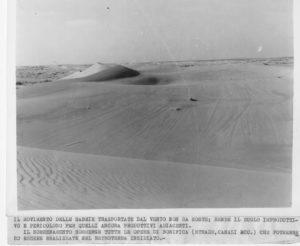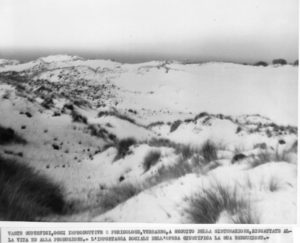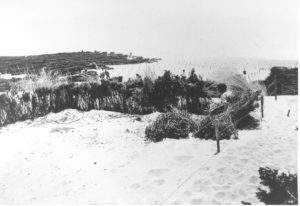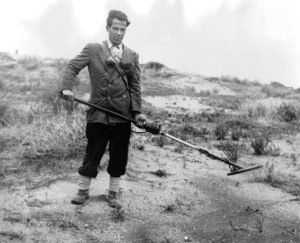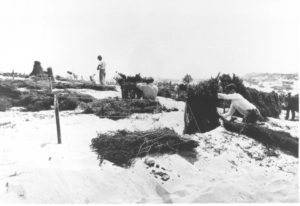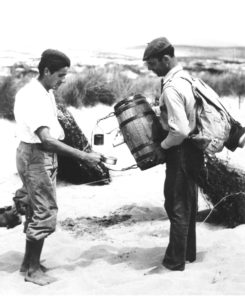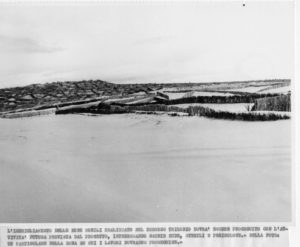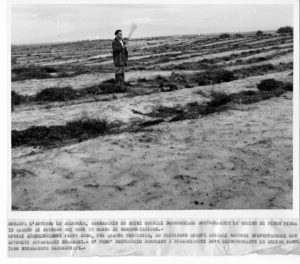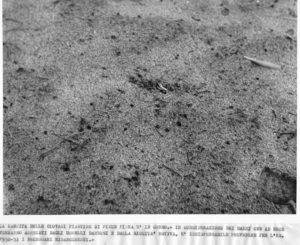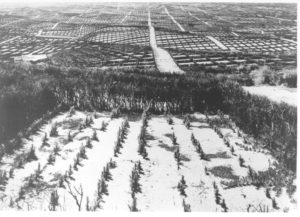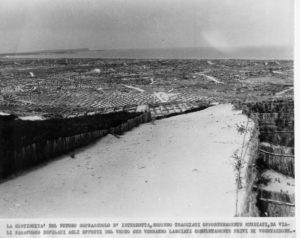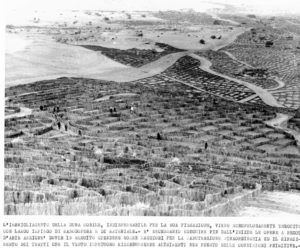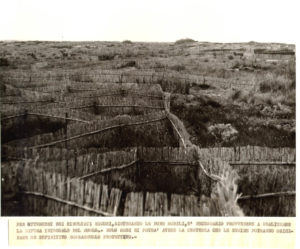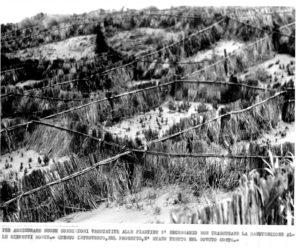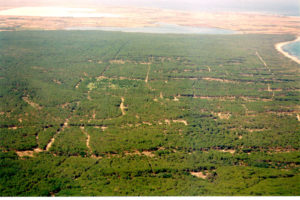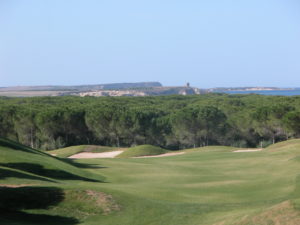THE REFORESTATION OF
IS ARENAS
an audacious environmental intervention
Sardinia has a rich and storied history. It is is one of the most geologically ancient bodies of land in Europe. Sardinia occupies a strategic position in the Mediterranean, and has been populated in various waves of emigration from prehistory until recent times. This turbulant past has shaped the present culture; celebrated with festivals, in the food and in the customs.
IS ARENAS is part of this rich culture, and it has it’s own story; Researching historical documents, can lead to pleasant discoveries if you have not experienced that particular time; giving curious details of interventions, even complex, as in this case, where we are given a small window into the “Reforestation of Is Arenas”.
 This is the story, told with old photographs, service accounts and work logs; documenting the physical and human efforts associated with the realization of a suitable artificial barrier to block or slow down the advance of sand dunes in the locality of Is Arenas.
This is the story, told with old photographs, service accounts and work logs; documenting the physical and human efforts associated with the realization of a suitable artificial barrier to block or slow down the advance of sand dunes in the locality of Is Arenas.
The need for such a desparate intervention was witnessed in various documents and writings, even from the previous century. One account dated from 1874 states, “The national road, which leads from Oristano to Cuglieri through Suni, half an hour out from Riola (Sardo), is impassible until nearly “Turre de Putzu”, and beyond for about one hour, because the sands cover it frequently. There is now remedy required extending from the beach…” These difficulties of transit and access are witnessed in photographs, presumably taken before 1950, before the beginning of interventions, and which admirably highlight the abundance of sand and the continuous shifting dunes.
The intervention had to take into account the desolate environment, where a forest was to eventually exist. An environment certainly adverse to vegetative requirements of the plants, due to: the violence and the frequency of the winds often loaded with salinity (salt), for the sterility of the sands and the paucity of precipitation – ever irregular and capricious.
The “intervention” of the coastline from the pond of Sassu (Arborea) to S. Caterina (Cuglieri) was prepared with a “General Master Plan in 1951 with a loan of Lire 1,526,455,000 (equal to approx. 2,500,000 euros in at today’s value); the purpose of the intervention concerned the stabilization of the “quicksand”; and the establishment of a coastal protection belt of the Gulf of Oristano.
The project began in a decisive manner on March 14, 1952, following a small preparatory work carried out in the previous year (from the date from 09.30.1951). The human effort, was “numerically considerable”, (April 23, 1956 – the date corresponding to the opening of the yard No. 2 Is Arenas to Is Benas – between a yard and the other were counted at work No. 601 workers, mostly from Narbolia, Riola, Cuglieri, as well as S.Vero Milis Cabras, Oristano and Scano Montiferro).
Transplants of various forest species (Stone Pine and Aleppo Pine, Australian acacia, Tamarisk and other species) were preceded by a thorough job of dune fixation through a dense network of wind-breaks, designed to stop the continuous movement march of sand inland.
The dune stabilization began near the sea and continued away from the coast, with the construction of a first wind-breaks oriented parallel to the line of ordinary tide. These barriers were spaced 30 meters distant from each other. The wind-break system was of the elastic type; to render a greater protection. The individual elements of the “hedges” were not a completely impenetrable wall to wind and weather. It is also noted; for no reason, could Beach grass or other existing vegetation be removed or eradicated within the work areas. It is therefore constituted a windbreak barrier with suitably intertwined bundles and tied to the wire stretched between the poles. In the period 08.02.1956 and 11.06.1956 there was a production equal to n ° 91,712 faggots (a faggot is a unit of measure for sticks or wood, equal to 3ft long by 2ft in circumferance). These wind-breaks were prescribed by the Inspectorate Ripartimentale of Cagliari Forests, which supervised the construction management of intervention project.
Among the various workers, characterized in the intervention, is the that of the “Sminitore” or deminer and the “scarecrow”.
The “Sminitore” (deminer or mine detector) was inserted in the project in the summer of 1952, after the discovery of anti-tank mines from WWII in the sand. Upon discovering the mine problem, the first urgent resolution was to require the tractor owners and transport operators to sign a release form, stating they were acting under their own personal responsibility in the event of an accidental mine discharge. Eventually Sminitore’ were employed along with a specially educated team of research workers of mines in those areas where the site activity demanded thorough demining. The demining personnel were authorized to prevent both the passage of vehicles and workers, and the invtervention work on the dunes in areas not thoroughly “raked”. Their authority superceded even the project foremen. The Sminitore was paid, in addition to the standard blue-collar pay common to all workers, a monthly flat-rate allowance for risk demining – hazard pay!
The human “scarecrow”: The worker (in the photo) scares – larks, crows and other birds. It became necessary to prevent the “looting and considerable damage” imposed by the birds on the Stone Pine and Aleppo Pine seeds at the stage of germination. So it was organized that some workers were specifically used to ward off the harmful birds and animals, as far as possible, scaring them with specific noisy equipment.
The photos below (left) show the reforestation intervention project in progress and (right) what Is Arenas looks like today. Today, Is Arenas is the largest forest in Sardinia. It encompasses approximately 750 hectares of Pine forest.

